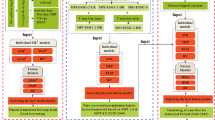Abstract
Floods are common in the upper Uruguay River, and they may occur almost at any moment, because there are not defined rainfall seasonal patterns. Moreover, there is not an official model for flood forecasting in this basin. This study developed a methodology for 1-month flood forecasting in the upper region of the Uruguay River basin (≥3000 m3 s−1), from the headwaters to the Itá reservoir. The monthly version of the SMAP (Soil Moisture Accounting Procedure) model was presented and used to describe the transformation of rainfall into runoff, and the CFSv2 (Climate Forecast System version 2) model was used to provide rainfall forecasts. Twenty-five 1-month-lead rainfall forecasts were used to calculate 25 flow predictions for every month. Ensembles with different number of members were compared among them and with the official model currently used for 1-month flow forecasting in the upper Uruguay River. The best accuracy was achieved with the average of the first seven members, which showed a mean relative error of 10.8 % during the floods, while the official model presented 64.0 %, predicting remarkably lower flows. Furthermore, during the period assessed, the correlation between the natural flow and the first-seven-member ensemble was >0.77, while with the official model was 0.34. Thus, coupling SMAP and CFS is a valid approach that can be useful to anticipate mitigating actions to decrease the effects of severe floods in the upper Uruguay River and, probably, in other Brazilian basins.










Similar content being viewed by others
References
Ahern M, Kovats RS, Wilkinson P, Few R, Matthies F (2005) Global health impacts of floods: epidemiologic evidence. Epidemiol Rev 27:36–46. doi:10.1093/epirev/mxi004
Alfieri L, Salamon P, Pappenberger F, Wetterhall F, Thielen J (2012) Operational early warning systems for water-related hazards in Europe. Environ Sci Policy 21:35–49. doi:10.1016/j.envsci.2012.01.008
Alfieri L, Pappenberger F, Wetterhall F, Haiden T, Richardson D, Salamon P (2014) Evaluation of ensemble streamflow predictions in Europe. J Hydrol 517:913–922. doi:10.1016/j.jhydrol.2014.06.035
Alfieri L, Burek P, Feyen L, Forzieri G (2015) Global warming increases the frequency of river floods in Europe. Hydrol Earth Syst Sci 19:2247–2260. doi:10.5194/hess-19-2247-2015
Bartholmes JC, Thielen J, Ramos MH, Gentilini S (2009) The European flood alert system EFAS—Part 2: statistical skill assessment of probabilistic and deterministic operational forecasts. Hydrol Earth Syst Sci 13:141–153
Block PJ, Souza Filho FA, Sun L, Kwon H-H (2009) A streamflow forecasting framework using multiple climate and hydrological models. J Am Water Resour As 45:828–843. doi:10.1111/j.1752-1688.2009.00327.x
Cataldi M, Saturnino Braga R, Dias TL, Sá RV, Rocha VF, Souza Filho FA (2012) Assessment of precipitation climate forecasting of models ECHAM 4.5, CFS, COLA/IRI and CCM3 for hydrographic basins in Southwest Brazil. In: CLIVAR VAMOS Workshop on Modeling and Predicting Climate in the Americas
Cloke HL, Pappenberger F (2009) Ensemble flood forecasting: a review. J Hydrol 375:613–626
Collischonn W, Tucci CEM, Clarke RT, Dias PL, Oliveira GS (2005) Previsão sazonal de vazão na bacia do rio Uruguai 2: previsão climática-hidrológica. Revista Brasileira de Recursos Hídricos 10:60–72 (In Portuguese)
Consórcio ITÁ (2015) Ficha técnica da UHE ITÁ. http://www.consorcioita.com.br/paginas/visualizar/ficha_tecnica/#conteudo. Accessed Jan 2015 (in Portuguese)
De Groeve T, Thielen J, Brakenridge R, Adler R, Alfieri L, Kull D, Lindsay F, Imperiali O, Pappenberger F, Rudari R, Salamon P, Villars N, Wyjad K (2014) Joining forces in a global flood partnership. Bull Am Meteorol Soc. doi:10.1175/BAMS-D-14-00147.1
FAO (2003) Review of water resources by country. ftp://fao.org/agl/aglw/docs/wr23e.pdf. Accessed Jan 2015
FAO (2015) Freshwater Availability - Precipitation and Internal Renewable Water Resources (IRWR). AQUASTAT database. http://www.fao.org/nr/water/aquastat/data/query/index.html. Accessed January 2015
Lopes J, Braga B, Conejo J (1982) SMAP—a simplified hydrological model, applied modelling in catchment hydrology. In: Singh (ed) Water Resources Publications
Lorenz EN (1967) The nature and theory of the general circulation of the atmosphere. World Meteorological Organization, Geneva
Milly PCD, Wetherald R, Dunne KA, Delworth TL (2002) Increasing risk of great floods in a changing climate. Nature 415:514–517. doi:10.1038/415514a
Ministério do Meio Ambiente (2006) Uruguay river hidrologic region report. Brasília, Environment Ministry (in Portuguese)
Nash J, Sutcliffe J (1970) River flow forecasting through conceptual models part I—a discussion of principles. J Hydrol 10:282–290. doi:10.1016/0022-1694(70)90255-6
ONS (2007) Technical note 133/2007. Electric System National Operator, Rio de Janeiro (in Portuguese)
Saha S, Nadiga S, Thiaw C, Wang J, Wang W, Zhang Q, Van Den Dool HM, Pan H-L, Moorthi S, Behringer D, Stokes D, Pena M, Lord S, White G, Ebisuzaki W, Peng P, Xie P (2006) The NCEP climate forecast system. J Clim 19:3483–3517. doi:10.1175/JCLI3812.1
Saha S, Moorthi S, Wu X, Wang J, Nadiga S, Tripp P, Behringer D, Hou Y-T, Chuang H, Iredell M, Ek M, Meng J, Yang R, Peña Mendez M, van den Dool H, Zhang Q, Wang W, Chen M, Becker E (2014) The NCEP climate forecast system version 2. J Clim 27:2185–2208. doi:10.1175/JCLI-D-12-00823.1
Sorensen JH (2000) Hazard warning systems: review of 20 years of progress. Nat Hazards Rev 1:119–125. doi:10.1061/(ASCE)1527-6988(2000)1:2(119)
Stillwell HD (1992) Natural hazards and disasters in Latin America. Nat Hazards 6:131–159. doi:10.1007/BF00124620
Thielen J, Bartholmes J, Ramos M-H, De Roo A (2009) The European flood alert system—part 1: concept and development. Hydrol Earth Syst Sci 13:125–140
Werner M, Reggiani P, De Roo AD, Bates P, Sprokkereef E (2005) Flood forecasting and warning at the river basin and at the European scale. Nat Hazards 36:25–42. doi:10.1007/s11069-004-4537-8
Acknowledgments
The authors express their sincere gratitude to Danielle Cristine Carvalho Muniz e Silva and to Prof. Thomas C. Harmon. They also thank Talmo Manhães de França Rodrigues, Carlos Henrique Silva and Yan Ferreira. Furthermore, the authors gratefully acknowledge the financial support provided by the Coordenação de Aperfeiçoamento de Pessoal de Nível Superior, CAPES, and by the Conselho Nacional de Desenvolvimento Científico e Tecnológico, CNPq.
Author information
Authors and Affiliations
Corresponding author
Rights and permissions
About this article
Cite this article
Fernández Bou, A.S., De Sá, R.V. & Cataldi, M. Flood forecasting in the upper Uruguay River basin. Nat Hazards 79, 1239–1256 (2015). https://doi.org/10.1007/s11069-015-1903-7
Received:
Accepted:
Published:
Issue Date:
DOI: https://doi.org/10.1007/s11069-015-1903-7




